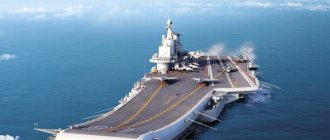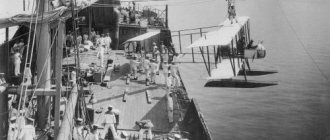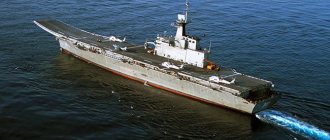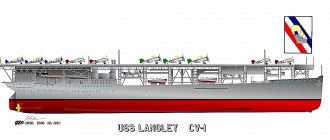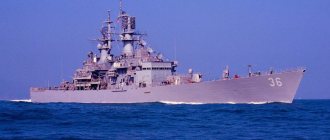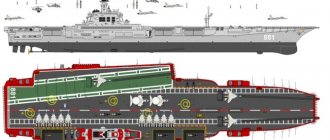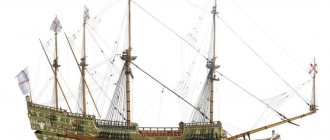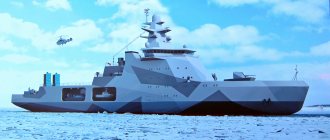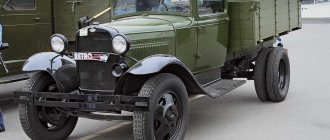Since their appearance in the ranks of military squadrons, aircraft carriers have changed the shape and nature of naval combat. They sent armadillos and battleships into “retirement”. The squadron commander was able to receive data about the environment within a radius of several hundred kilometers. Thanks to them, in local conflicts an advantage was created in air attack means (AEA). They personified the power of the state: the presence of at least one aircraft carrier in the fleet increased the status of any power, and the presence of a dozen elevated it to the rank of a superpower. But recently this class of ships has come under increasing criticism. Why?
The problem has matured
In September 2022, the American online publication The Business Insider published the article These are the world's 7 worst aircraft carriers that are currently in service, in which it rated the worst aircraft carriers in the world. The list includes our TAVKR Admiral Kuznetsov, the Thai aircraft carrier Chakri Naruebet, two Australian ones - Canberra and Adelaide, as well as two American ones - Wasp and the newest Gerald Ford.
Our aircraft-carrying cruiser was not criticized only by the laziest journalist from the foreign media, but for a new product, a ship that had just left the shipyard slips, to be included in the anti-rating is an unusual case.
Facts about breakdowns plaguing Gerald Ford periodically appear in various open sources of information. What is this - an ordinary case with the lead ship of the series or a pattern that the US Navy command is carefully hiding from taxpayers?
Following this, an article by expert Sam LaGrone about the current state of affairs with aircraft carriers appeared on the website of the US Naval Institute. Immediately after this, the Belgian Internet resource Dedefensa tried to shed light on what was happening with American aircraft carriers, which published its response to LaGrone’s article. The instant appearance of such an array of information indicates that the problem has “ripened.”
LaGron cites the following facts. The largest number of aircraft carriers - 30 ships - was in 1973, when the US Navy provided maximum air support to ground forces in South Vietnam. The same year marks the highest operational availability of aircraft carriers - 42% of the roster.
That is, during the Vietnam War, 12 such US Navy ships were involved in combat operations. In modern times, these are almost all American aircraft carriers. At the same time, there were periods when these ships spent more time at anchorage or in repair docks. Not surprisingly, this period occurred in 2018 - 15% operational availability and only 11 aircraft carriers in the fleet.
It would seem, what is wrong with this information? For ordinary American citizens, an aircraft carrier at anchor is a reason for excursions or a chance to attend an air show dedicated to US Independence Day. Experts consider such a simple trend to be a dangerous trend.
As an introduction
In our modern times, there are only ten states in the world that have aircraft carriers as part of their naval forces. The undisputed leaders of the conditional rating are the Americans, who have 11 aircraft carriers. Second place was shared between Italy and Spain. These countries each have two of these ships. Next come China, Russia, France, Brazil, India, Thailand, and Great Britain. All of these states have one aircraft carrier.
They counted and shed tears...
In 2022, the US Government Accountability Office published a report on the state of the US Navy. The report states, in part: “Currently available shipyard dry dock capacity does not meet the needs of future operations. The Navy estimates that the plants will not be able to complete 73 of the 218 maintenance operations planned over the next 23 years. In particular, this applies to (all) aircraft carriers and 50 submarines.”
The Government Accountability Office's findings stand in contrast to US Defense Secretary James Mattis's announcement of the US Navy's "Dynamic Force Deployment" strategy, which works in concert with another strategy, "Global Snap Strike." According to regulations, the US Navy must deploy its ships, including aircraft carriers, within 96 hours anywhere on the planet to launch the first disarming strike against any enemy.
In 2022, Dynamic Force Deployment suffered several setbacks. In April 2022, the aircraft carrier Harry Truman joined the military operation to “punish Assad.” But his participation became more symbolic than effective. After that, in order to show Iran “whose slippers are in the house,” the ship was supposed to take a position in the Persian Gulf, but instead it went to its home port for repair work. In Norfolk, fellow ships “Dwight Eisenhower” and “George Bush” were already waiting for him, the repair period of which was extended for another year.
The piquancy of what happened is that the head of the Pentagon, James Mattis, using the example of the aircraft carrier Harry Truman, wanted to demonstrate to all allies of the United States a model of response within the framework of the announced “Dynamic Deployment of Forces” strategy. But something went wrong, and “Harry Truman” is only on August 28, 2022 - in three months! - went out to sea again.
Experts ask a rhetorical question about how the endless repairs of the Nimitz-class aircraft carriers and the failures of the Gerald Ford aircraft carrier will affect assistance to the allies or the use of force during combat operations? This is how the authors of the Internet resource Dedefensa respond to this.
“As a result, all aircraft carriers in service become increasingly vulnerable, turning into real “ugly ducklings”, locked at their berths and paralyzed by the need for constant maintenance. This situation is increasingly affecting all aspects of the armed forces, which are becoming more technically heavy. The technology is becoming increasingly expensive and difficult to use. This primarily affects aircraft carriers: logistics operations become wider and longer, and everything can ultimately come to a catastrophic impasse. This is what Mattis apparently calls “Dynamic Deployment of Forces”..."
Wartime tasks
When considering the combat missions of aircraft carriers, it is advisable to familiarize yourself with the purpose of the entire aircraft carrier strike group, which was created to:
- Strikes at various targets located both on the coast and on land.
- Air cover and support for landing forces and ground units that conduct their operations in the coastal zone.
- Gaining and maintaining absolute superiority in the airspace in the area of the planned military operation.
- Providing air defense for other ships, landing forces, convoys while they are moving across the sea.
- Blockades of the enemy's coastal line.
- Conducting tactical aviation reconnaissance.
As a matter of fact, in peacetime, the United States, through the use of air strike groups, shows the whole world its power and strength in key regions of the planet from a political point of view for the country.
Last straw
Indeed, from a certain time, the pride of the US Navy - aircraft carriers - began to appear less and less in various parts of the World Ocean. As it turned out, this is not due at all to a lack of desire to bring the “values of Western democracy” to all resisting “undemocratic” countries, but to problems that have arisen in the US defense complex, in particular with shipbuilding firms.
Facts related to technical problems with the aircraft carrier Gerald Ford, the destroyer Zamwalt and problems with welds during the construction of Virginia-class nuclear submarines turned out to be just the tip of the iceberg, the underwater part of which was hidden for a long time behind the screen of expensive projects. While American admirals were offered “wonder weapons” in the form of a stealth aircraft carrier (Gerald Ford) or a ship with a railgun (Zamwalt), the repair docks were filled to capacity with ships that form the backbone of the US Navy.
It was the aircraft carriers that became the last straw that revealed the unsatisfactory state of the US Navy, and perhaps that is why Donald Trump started talking about the possible imminent resignation of James Mattis. This is not surprising: speaking at the election debates, Trump promised the Americans to increase the power of the country’s fleet to 355 units by commissioning new surface ships and submarines. To meet these promises, the Pentagon was allocated a record budget of $716 billion.
And suddenly such a puncture! Aircraft carriers break down - both new and old. The allies are indignant, the Russians and the Chinese are laughing. And at the same time, the information that Russia has hypersonic anti-ship missiles turns out to be reliable...
The situation with aircraft carriers is similar to the situation in the US Air Force, where 60% of the aircraft fleet requires urgent repairs. At the same time, new F-35 aircraft also constantly break down, causing skepticism among potential customers. And the Minuteman-3 ballistic missiles did not perform well during testing.
Universal landing ships are sub-aircraft carriers. Where is the mind?
However, the very nature of these attempts emphasizes the fundamental nature of the impasse that has arisen rather than the presence of light at the end of the tunnel.
First of all, the US Navy set about revising the concept of using its aircraft carrier forces. Due to the enormous cost and growing vulnerability of large aircraft carriers, an attempt was made to shift the center of gravity of breaking through the “forbidden zones” to the Marine Corps and universal landing ships (UDC) armed with attack carrier-based aircraft.
© marines.mil
Marine Corps amphibious assault ship USS Makin Island.
However, today it has become quite obvious that this is an attempt with unsuitable means. UDCs equipped with F-35B aircraft, which have very limited combat capabilities in comparison with the strike aircraft of classic aircraft carriers, turned out to be something like underdeveloped aircraft-carrying ships capable of performing a limited range of operations against militarily extremely weak countries.
American Titans
So, let's take a closer look at how many aircraft carriers there are in the United States. As mentioned above, there are eleven of them. The list of US aircraft carriers is as follows:
- "Nimitz".
- "Dwight Eisenhower."
- "Theodore Roosevelt."
- "Carl Vinson."
- "Abraham Lincoln".
- "George Washington".
- "John C. Stennis."
- "Harry Truman".
- "George Bush".
- "Ronald Reagan."
- "Gerald R. Ford."
Now let's get to know them better.
Fortieth President of the United States
The aircraft carrier Ronald Reagan became a full member of the fleet in July 2003. The ship has a couple of significant differences from its “brothers”. The first is the presence of three (not four) high-strength brake cables. Secondly, the bow of the ship has a bulbous shape, which was done to increase the stability of the entire aircraft carrier.
The Ronald Reagan is capable of carrying about ninety helicopters and airplanes on board. The main striking force of the ship is the F/A-18 Hornet multi-purpose combat aircraft, which have already been tested many times in practice in various US combat operations.
The Second World War
For the US Navy, the war began in December 1941, when Japan attacked the US Pacific Fleet base at Pearl Harbor. Over the course of two raids, 353 aircraft took off from 6 Japanese aircraft carriers. As a result of the attacks, 14 ships and more than 200 aircraft were sunk or damaged, and about 2.5 thousand people were killed. No one expected such aggression from Japan. The United States declared war on the “Land of the Rising Sun” on the same day. By coincidence, only old ships were in Pearl Harbor at the time of the attack. Modern aircraft carriers were located on another part of the American coast.
Essex-class aircraft carriers
In the same year, 1941, 3 Essex-class aircraft carriers were laid down, which belonged to the strike class of aircraft carrier ships. The design began 3 years before the start of construction. Initially, it was planned to build only one such ship. However, after the attack on the Pearl Harbor base, a decision was urgently made to create two additional ships. In total, 24 aircraft carriers of this type were produced during the war years. It is noteworthy that the Essex took part in many battles, but not a single ship was sunk. The length of the vessel was 266 m, the maximum speed reached 33 knots, the crew included 3,000 people (in accordance with the staffing table, 2,386 people). The equipment included about 100 aircraft, anti-aircraft artillery and radar weapons.
Essex-class aircraft carriers
| Type: Attack aircraft carriers "Essex" | ||
| Name | Commissioned | Removed from the fleet |
| "Essex" USS Essex (CV/CVA/CVS-9) | December 31, 1942 January 15, 1951 | January 9, 1947 June 30, 1969 |
| "Yorktown" USS Yorktown (CV/CVA/CVS-10) | April 15, 1943 January 2, 1953 | January 9, 1947 June 27, 1970 |
| "Intrepid" USS Intrepid (CV/CVA/CVS-11) | August 16, 1943 | March 15, 1974 |
| Hornet Hornet (CV/CVA/CVS-12) | November 29, 1943 March 20, 1951 September 11, 1953 | January 15, 1947 May 12, 1951 July 25, 1989 |
| "Franklin" USS Franklin (CV/CVA/CVS-13, AVT-8) "Big Ben" "Big Ben" | January 31, 1944 | February 17, 1947 |
| Ticonderoga USS Ticonderoga (CV/CVA/CVS-14) | May 8, 1944 October 1, 1954 | January 9, 1947 September 1, 1973 |
| "Randolph" USS Randolph (CV/CVA/CVS-15) | October 9, 1944 July 1, 1953 | February 25, 1948 February 13, 1969 |
| "Lexington" USS Lexington (CV/CVA/CVS/CVT/AVT-16) "The Blue Ghost" "The Blue Ghost" | February 17, 1942 | November 8, 1991 |
| "Bunker Hill" USS Bunker Hill (CV-17) | May 24, 1943 | January 9, 1947 |
| "Wasp" USS Wasp (CV-18) | November 24, 1943 | July 1, 1972 |
| "Hancock" USS Hancock (CV-19) | April 15, 1944 March 1, 1954 | May 9, 1947 January 31, 1976 |
| Bennington USS Bennington (CV-20) | August 6, 1944 | January 15, 1970 |
| "Boxer" USS Boxer (CV-21) | April 16, 1945 | December 1, 1969 |
| "Bon Homme Richard" USS Bon Homme Richard (CV-31) | November 26, 1944 October 1, 1952 | January 9, 1947 July 2, 1971 |
| "Leyte" USS Leyte (CV-32) | April 11, 1946 | May 15, 1959 |
| USS Kearsarge (CV-33) | March 2, 1946 | February 13, 1970 |
| "Oriskany" USS Oriskany (CV-34) | September 25, 1950 | September 30, 1976 |
| Antietam USS Antietam (CV/CVA/CVS-36) | January 28, 1945 | May 8, 1963 |
| Princeton USS Princeton (CV-37) | November 18, 1945 August 28, 1950 | June 21, 1949 January 30, 1970 |
| "Shangri-La" USS Shangri-La (CV-38) | September 15, 1944 February 1, 1955 | November 7, 1947 July 30, 1971 |
| "Lake Champlain" USS Lake Champlain (CV-39) | June 3, 1945 September 19, 1952 | February 17, 1947 December 1, 1969 |
| "Tarawa" USS Tarawa (CV/CVA/CVS-40, AVT-12) | December 8, 1945 February 3, 1951 | June 30, 1949 May 13, 1960 |
| Valley Forge USS Valley Forge (CV-45) | November 3, 1946 | January 15, 1970 |
| "Philippine Sea" USS Philippine Sea (CV-47) | May 11, 1946 May 15, 1959 | December 28, 1958 December 1, 1969 |
Long Island-class aircraft carriers
Considering the slow speed of construction of attack aircraft-carrying ships, a decision was made to re-equip a number of transport ships. An escort aircraft carrier could be built in a few months. In the early 40s, 2 transport ships were converted, one of which was transferred to the British Navy. The American Long Island was used primarily as a training base for pilots and escorts for other ships; only once did it take a mediocre part in ensuring security during the Battle of Midway. The ship had a length of 150 meters, a speed of about 16 knots and a crew of up to 1000 people. Armament included 16 aircraft. After the end of the war he was removed from service, but served for many years after that for civilian purposes until 1977.
Long Island type
Avenger-class aircraft carriers
During the same period, another 4 transport ships were converted into escort aircraft carriers, some of which were transferred to the US partner - Great Britain. The technical characteristics of the ship were practically no different from the Long Island-class aircraft carriers, except that not 16, but 15 aircraft were based on board. A German submarine was able to sink the main of the four ships described near Gibraltar.
Ranger-class aircraft carrier
The Ranger is the first attack ship originally designed as an American aircraft carrier. The runway looked like an above-deck structure made of wood and topped with a thin layer of steel for protection in case of fire. The chimney was divided into 6 pipes - three on each side. Depending on the direction of the wind, one or the other side was connected, thereby ensuring normal visibility for takeoff and landing of aircraft. The ship had been in service since 1934, patrolled the Atlantic Ocean during the war, and took part in 1942 operations in North Africa. During this time, 496 aircraft sorties were carried out from the ship. At the end of the war, the ship was withdrawn from the fleet and sold as scrap in 1947. The length of the Ranger was almost 235 meters, the speed was 29 knots, and the aviation group consisted of 86 aircraft.
Yorktown-class aircraft carriers
In the 30s of the last century, 3 aircraft-carrying ships were also built, which were a modernized copy of the Ranger. All of them were actively used in military battles. Just a year after the United States entered the war, 2 Yorktowns were sunk, and the third aircraft carrier, Enterprise, was withdrawn from service in 1947. The length of the ships was 246 meters, the speed was 32.5 knots, and each ship was assigned 96 aircraft. Particularly notable was the USS Enterprise, considered the most famous United States Navy ship in the Pacific during World War II. The ship took an active part in the battles at Midway Atoll.
It is worth talking in more detail about the Battle of Midway, since this battle was one of the most important that influenced the outcome of the war. Understanding the growing power of American aircraft carriers, Japan planned in detail a surprise attack on US naval forces based in the Midway Atoll area. However, US cryptographers managed to declassify the code and learned about the enemy’s tasks. Deciding to be proactive, Admiral Nimitz sent 3 fully equipped Yorktown-class aircraft carriers. As a result of heavy battles, Japan lost 4 heavy aircraft carriers and 248 aircraft and thereby missed the opportunity to conduct an attacking line of conduct in the war. The United States lost one of the Yorktown aircraft carriers in this battle.
| Type: Yorktown Attack Carriers | ||
| Name | Commissioned | Removed from the fleet |
| Yorktown USS Yorktown (CV-5) | September 30, 1937 | October 2, 1942 |
| Enterprise USS Enterprise (CV-6) | May 12, 1938 | February 17, 1947 |
| Hornet USS Hornet (CV-8) | October 20, 1941 | October 26, 1942 |
Wasp-class aircraft carrier
This type is represented by only one example of the ship. It was a stripped-down version of Yorktown. "Wasp" was put into operation in 1940, with the beginning of US participation in the war, the ship patrolled the waters of the Atlantic Ocean and repeatedly transported land aircraft from England to the Mediterranean. In 1942, Wasp and its aircraft ensured the safe passage of American ships. However, a Japanese submarine met on his way. When attacked by the Japanese Navy, the aircraft carrier was damaged and then sunk.
Independence-class aircraft carriers
In conditions of an acute shortage of aircraft carriers during the Second World War, several more light aircraft-carrying ships (Independence class) were created, rebuilt from the Cleveland cruisers. Over the course of 2 years, 9 such vessels were converted. Despite their small size and vulnerability, they were actively exploited during the war. After the war and the development of aviation, the small size of the deck did not allow aircraft carrier cruisers to be used for their intended purpose, so in 1946-47 all of them were withdrawn from US Navy service. Some of them were transferred to the navies of France and Spain, some were used in nuclear tests, and the rest were scrapped. The Independence was 190 meters long and could accommodate up to 30 aircraft.
Independence-class aircraft carriers
| Type: Light aircraft carriers "Independence" | ||
| Name | Commissioned | Removed from the fleet |
| Aircraft carrier USS Independence (CVL-22) | January 1, 1943 | August 28, 1946 |
| Princeton USS Princeton (CVL-23) | February 25, 1943 | October 24, 1944 |
| "Bello Wood"/"Bois Belleau" Belleau Wood/Bois Belleau | March 31, 1943 (USA) December 23, 1953 (France) | 1960 |
| Langley/La Fayette Langley/La Fayette | August 31, 1943 (USA) June 2, 1951 (France) | February 9, 1964 |
| "Cabot"/"Dedalo" Cabot/Dedalo | November 17, 1943 (USA) August 30, 1967 (Spain) | 1989 |
Saipan-class aircraft carriers
A group of light aircraft carriers from the 1940s, created as replacements for the supposed losses of the Independence. Two ships of this type were built, both of which never entered service during wartime. At the end of the war, the intensive development of jet aircraft began; Saipan could no longer take such heavy equipment on board. In view of this, the ships acted as auxiliary vessels or training exhibits and were withdrawn from service only at the end of the 70s of the last century.
Bogue-class aircraft carriers
A group of World War II escort aircraft carriers, most often used by the British Allies. A total of 45 units of equipment were converted. The distinctive features of these escort aircraft carriers were the following indicators. Due to a shortage of diesel engines, the Bogue used a hull with steam turbine units - this increased the amount of gas produced, but also contributed to the vessel's greater speed. The length of the ship was increased, and the deck itself was protected by 6-mm steel sheets, all this made it possible to take on board heavier aircraft.
Bogue type
Casablanca-class aircraft carriers
The largest group of escort aircraft carriers, 50 units were created during the war, the ships were built in a record 4 months. "Casablanca" differed from "Bogue" in greater speed and increased hangar space, but they could not cover long distances. Also, their deck was shorter than the previous Bogues, so take-off and landing of aircraft was difficult. During the war, aircraft carriers were actively used to support landing forces. 5 ships were lost during the battles. At the end of hostilities, the Casablanca became unusable due to its small deck size.
Sengamon-class aircraft carriers
Four Sangamon-class escort carriers were converted from unfinished oil tankers and also served in World War II. The ships served in the Atlantic and later the Pacific Ocean. The cost of such ships was quite high, so not a large amount of equipment was built. All of the Sangamon aircraft carriers were involved in Operation Torch. The aircraft armament included 14 fighters and 17 bombers of various types. During one of the campaigns, the Sengamon was discovered by Japanese ships. The aircraft carrier tried to break away from the enemies, but the very next day it was attacked by a plane that crashed into the deck. The hole on the deck reached 40 m², a few minutes later the aircraft carrier was torpedoed by a submarine. On the same day, 2 more kamikazes crashed into the side of the ship, leaving more and more holes and hundreds of dead. Despite this, the Sengamon continued to sail.
